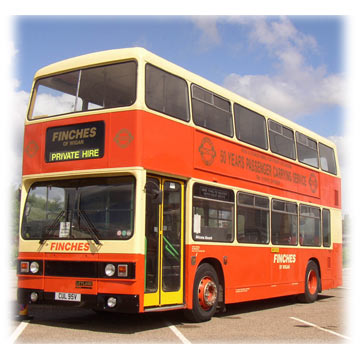The Convenience Bus
How to Reinvigorate Local Bus Services (Page 2)
Contents:
Competition
If services are too infrequent, or finish early in the day, they cease to relevant to most users. If people are unable to wait longer than 10 minutes, some would walk back home, ring a family member or a friend for a lift, or a taxi to their desired destination.
Imagine if a local supermarket decided to close certain aisles on Sundays or Bank Holidays. Firstly, there would be mutiny. Then mutiny would follow exodus, which leads to shoppers buying their groceries elsewhere. Ultimately that store would lose business, leading to an eventual closure.
Now imagine this scenario with a local bus route: people would feel daunted waiting longer for their desired service, if one or two journeys were missing or too far apart in the timetable. Some may complain, and complain. Nothing may happen. Meanwhile, only staunch users of the service would get this bus, as casual users may be deterred. The company may assume the service is a loss maker, or it becomes uneconomical to subsidise, resulting in withdrawal. Unlike supermarkets, bus routes are harder to replace, given current trends towards car ownership (187,000 new cars sold in 2005 - double the figures of 1997).
The real competition lies in increased car dependency and local private hire companies.. For instance, it is cheaper for four adults in Greater Manchester (without concessionary passes, day rover or season tickets) to take a taxi from the Broadoak Hotel to Ashton town centre, than four single fares.
In some areas, bus services have been partly replaced by demand responsive travel, or shared taxi services. Unlike regular bus services, these are restricted to persons living within that locality. Fares are usually similar to single bus fares, or slightly cheaper.
The up side of demand responsive transport, are that of a more personalised service. Rather than sticking to a familiar route, travel to and from works, usually on a zonal basis, with the convenience of a taxi, though with fares akin to local bus services. Demand responsive transport, has a higher footprint, with some vehicles being able to negotiate narrower streets, out of bounds to scheduled bus services. One other (more obvious) advantage is improved waiting facilities (the lounge/living room rather than a windy bus stop).
One down side of this, is that such services could be seen as a cheaper alternative to running a fully fledged bus service. Though convenient for residents of that area, non drivers, living outside the zone, making a casual visit to that area are unable to do so, as no bus service may exist. One example of this is the 188 service, where one section after 1900 hours is wholly demand responsive. One other problem is that demand responsive transport could put pressure on existing taxi bookings, due to reduced vehicle availability - leading to longer waits outside the taxi rank or pub doorway.
The car, for many persons is often seen as the cheapest and most effective form of transport, with the cost of ownership falling. For many, it is too convenient for the car to be the first form of transport, even for the shortest of distances, without considering other alternatives.
The convenience bus
With people working longer hours, due to unpaid overtime, longer commuting times, and also unsocial hours, there is a need for the local bus service to become a 'Co-op on Wheels'. As the slogan ("We go further, so you don't have to") suggests, a greater effort towards increased local services is required. The emphasis on this philosophy should aim to:
- Reduce the amount of short distance car journeys;
- Revitalise local town centres and facilities;
- Restore faith in local bus services;
- Increase patronage not only on local routes but also longer distance services.
Fares:
With the main competition coming from taxis and private car ownership, hop-on fares should also be keenly priced. To differentiate from longer distance services, single or return fares should reflect this.
In Redditch and Worcester, First Midland Red rationalised its fare structures on local services to an affordable maximum adult fare of £1.20 (now £1.40). The result was a slight increase in patronage and faster boarding times.
The maximum fare should also be set to an easy to remember rate. For example, a £1.00 per adult maximum (or flat fare) on the 331 is more memorable than £1.50 or 95p. A £1.00 maximum or flat fare on this route could reduce boarding times, with this effect more marked at busy stops, for example the Broadoak Hotel, or The Ash Tree Wetherspoons house.
Frequencies:
In addition to instantly memorable flat rate fares, this should also be applicable with timetables.
From past experience, I have witnessed persons asking drivers whether bus X goes to the hospital. To their disappointment, they were told otherwise, due to the uneven frequency of that service.
For the uninitiated, gaps in services deters potential users, racking their brains as to why service Y only runs to the hospital in the daytime, whereas service X goes to the same destination all day. As well as town centres, the 'Co-op on Wheels' should also service local hospitals, with constant frequencies.
Most people, when told how often, for example the 346 runs, are told the service runs every 15 minutes, without thinking that this only applies to the daytime frequency (Sundays and Bank Holidays excepted). Assuming the same mindset applies to most current or potential passengers, 15 minutes on a relatively short route should mean 15 minutes all day long. A winning combination of good value single fares and a steady frequency should increase confidence in that service, and ultimately reduce car dependency.
